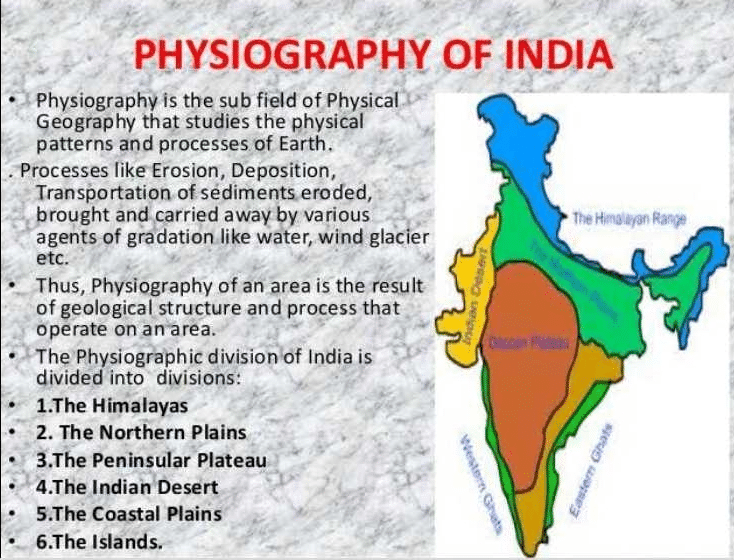Class 9 Exam > Class 9 Questions > Which are the major physiographic divisions o...
Start Learning for Free
Which are the major physiographic divisions of India? Explain any two briefly.
?Most Upvoted Answer
Which are the major physiographic divisions of India? Explain any two ...
The major physiographic divisions of India are:
1. The Northern Mountains: This division includes the Himalayas, which are the highest mountain ranges in the world. The Himalayas are divided into three parallel ranges, namely the Great Himalayas, the Lesser Himalayas, and the Outer Himalayas. The Northern Mountains are the source of many of India's major rivers, such as the Ganga, Brahmaputra, and Indus. The region is also home to a diverse range of flora and fauna, including snow leopards, red pandas, and rhododendrons.
2. The Indo-Gangetic Plain: This division includes the fertile plains of the Ganga and its tributaries, as well as the Indus and its tributaries. The Indo-Gangetic Plain is one of the most densely populated regions in the world, with a rich agricultural tradition. The region is also home to several important Indian cities, such as Delhi, Kolkata, and Lucknow.
One major challenge facing the Indo-Gangetic Plain is air pollution, which is caused by a combination of vehicle emissions, industrial activity, and biomass burning. This pollution has significant health impacts for the region's residents and contributes to climate change on a global scale.
1. The Northern Mountains: This division includes the Himalayas, which are the highest mountain ranges in the world. The Himalayas are divided into three parallel ranges, namely the Great Himalayas, the Lesser Himalayas, and the Outer Himalayas. The Northern Mountains are the source of many of India's major rivers, such as the Ganga, Brahmaputra, and Indus. The region is also home to a diverse range of flora and fauna, including snow leopards, red pandas, and rhododendrons.
2. The Indo-Gangetic Plain: This division includes the fertile plains of the Ganga and its tributaries, as well as the Indus and its tributaries. The Indo-Gangetic Plain is one of the most densely populated regions in the world, with a rich agricultural tradition. The region is also home to several important Indian cities, such as Delhi, Kolkata, and Lucknow.
One major challenge facing the Indo-Gangetic Plain is air pollution, which is caused by a combination of vehicle emissions, industrial activity, and biomass burning. This pollution has significant health impacts for the region's residents and contributes to climate change on a global scale.
Community Answer
Which are the major physiographic divisions of India? Explain any two ...


|
Explore Courses for Class 9 exam
|

|
Similar Class 9 Doubts
Which are the major physiographic divisions of India? Explain any two briefly. Related: Extra Question & Answers (Part - 2) - Physical Features of India?
Question Description
Which are the major physiographic divisions of India? Explain any two briefly. Related: Extra Question & Answers (Part - 2) - Physical Features of India? for Class 9 2025 is part of Class 9 preparation. The Question and answers have been prepared according to the Class 9 exam syllabus. Information about Which are the major physiographic divisions of India? Explain any two briefly. Related: Extra Question & Answers (Part - 2) - Physical Features of India? covers all topics & solutions for Class 9 2025 Exam. Find important definitions, questions, meanings, examples, exercises and tests below for Which are the major physiographic divisions of India? Explain any two briefly. Related: Extra Question & Answers (Part - 2) - Physical Features of India?.
Which are the major physiographic divisions of India? Explain any two briefly. Related: Extra Question & Answers (Part - 2) - Physical Features of India? for Class 9 2025 is part of Class 9 preparation. The Question and answers have been prepared according to the Class 9 exam syllabus. Information about Which are the major physiographic divisions of India? Explain any two briefly. Related: Extra Question & Answers (Part - 2) - Physical Features of India? covers all topics & solutions for Class 9 2025 Exam. Find important definitions, questions, meanings, examples, exercises and tests below for Which are the major physiographic divisions of India? Explain any two briefly. Related: Extra Question & Answers (Part - 2) - Physical Features of India?.
Solutions for Which are the major physiographic divisions of India? Explain any two briefly. Related: Extra Question & Answers (Part - 2) - Physical Features of India? in English & in Hindi are available as part of our courses for Class 9.
Download more important topics, notes, lectures and mock test series for Class 9 Exam by signing up for free.
Here you can find the meaning of Which are the major physiographic divisions of India? Explain any two briefly. Related: Extra Question & Answers (Part - 2) - Physical Features of India? defined & explained in the simplest way possible. Besides giving the explanation of
Which are the major physiographic divisions of India? Explain any two briefly. Related: Extra Question & Answers (Part - 2) - Physical Features of India?, a detailed solution for Which are the major physiographic divisions of India? Explain any two briefly. Related: Extra Question & Answers (Part - 2) - Physical Features of India? has been provided alongside types of Which are the major physiographic divisions of India? Explain any two briefly. Related: Extra Question & Answers (Part - 2) - Physical Features of India? theory, EduRev gives you an
ample number of questions to practice Which are the major physiographic divisions of India? Explain any two briefly. Related: Extra Question & Answers (Part - 2) - Physical Features of India? tests, examples and also practice Class 9 tests.

|
Explore Courses for Class 9 exam
|

|
Signup for Free!
Signup to see your scores go up within 7 days! Learn & Practice with 1000+ FREE Notes, Videos & Tests.


























